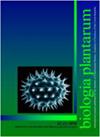Topical application of double-stranded RNA molecules deriving from Tomato yellow leaf curl virus reduces cognate virus infection in tomato
IF 0.9
4区 生物学
Q4 PLANT SCIENCES
引用次数: 9
Abstract
Tomato yellow leaf curl virus (TYLCV), a whitefly-transmitted single-stranded DNA (ssDNA) virus, causes the most important viral disease of tomato worldwide. TYLCV-mediated disease is mainly controlled via extensive insecticide sprays aiming at the whitefly vector. RNA-based vaccination was proven to be a non-transgenic approach leading to efficient plant virus control. In this work, double-stranded RNA (dsRNA) molecules deriving from sequences of the C4 and V2 genes of TYLCV-Mild were produced in vitro and topically applied onto tomato plants along with the virus (via agroinfiltration). DsC4 and dsV2 application reduced disease incidence to 23 and 46 %, respectively, while TYLCV positive control reached 64 %. Bioinformatics analysis of the virus-specific small interfering RNAs (vsiRNAs) from TYLCV-infected tomato revealed 'hot' and 'cold' spots in the TYLCV-Mild genome. Interestingly, the viral C-strand had twofold siRNA reads when compared to that of the V-strand. Overall, vsiRNAs of negative and positive polarity were almost equal (53.5 vs. 46.6 %); vsiRNAs of negative polarity prevailed at the V-strand. Stem-loop RT-PCR validated the presence of six vsiRNAs (hot or cold spots) in TYLCV-Mild-infected and dsRNA-treated tomato. The exogenously applied dsRNA was found to rapidly move systemically in tomato and was detected for 54 days post treatment (dpt). The applied dsRNA molecules were successfully processed by the Dicer-like proteins (DCLs) in tomato since small interfering RNAs (siRNAs) deriving from the dsRNA were detected for at least 54 dpt. This consists the first report of dsRNA-based vaccination applied against a monopartite geminivirus.番茄黄叶卷曲病毒双链RNA分子的局部应用减少番茄同源病毒感染
番茄黄叶卷曲病毒(TYLCV)是一种由白蝇传播的单链DNA(ssDNA)病毒,是世界范围内番茄最重要的病毒性疾病。TYLCV介导的疾病主要通过针对粉虱媒介的广泛杀虫剂喷雾来控制。基于RNA的疫苗接种已被证明是一种非转基因方法,可有效控制植物病毒。在这项工作中,来源于TYLCV温和型C4和V2基因序列的双链RNA(dsRNA)分子在体外产生,并与病毒一起(通过农业渗透)局部应用于番茄植株上。DsC4和dsV2的应用将疾病发生率分别降低到23%和46%,而TYLCV阳性对照达到64%。对TYLCV感染番茄的病毒特异性小干扰RNA(vsiRNA)的生物信息学分析揭示了TYLCV轻度基因组中的“热点”和“冷点”。有趣的是,与V链相比,病毒C链的siRNA读数是V链的两倍。总体而言,负极性和正极性的vsiRNA几乎相等(53.5%对46.6%);负极性的vsiRNA在V链上占主导地位。茎环RT-PCR验证了TYLCV轻度感染和dsRNA处理的番茄中存在六个vsiRNA(热点或冷点)。发现外源应用的dsRNA在番茄中快速系统移动,并在处理后54天内检测到(dpt)。番茄中的Dicer样蛋白(DCLs)成功地处理了所应用的dsRNA分子,因为从dsRNA衍生的小干扰RNA(siRNA)被检测到至少54dpt。这是第一份基于dsRNA的疫苗接种单体双子病毒的报告。
本文章由计算机程序翻译,如有差异,请以英文原文为准。
求助全文
约1分钟内获得全文
求助全文
来源期刊

Biologia Plantarum
生物-植物科学
CiteScore
2.80
自引率
0.00%
发文量
28
审稿时长
3.3 months
期刊介绍:
BIOLOGIA PLANTARUM is an international journal for experimental botany. It publishes original scientific papers and brief communications, reviews on specialized topics, and book reviews in plant physiology, plant biochemistry and biophysics, physiological anatomy, ecophysiology, genetics, molecular biology, cell biology, evolution, and pathophysiology. All papers should contribute substantially to the current level of plant science and combine originality with a potential general interest. The journal focuses on model and crop plants, as well as on under-investigated species.
 求助内容:
求助内容: 应助结果提醒方式:
应助结果提醒方式:


